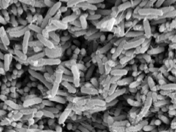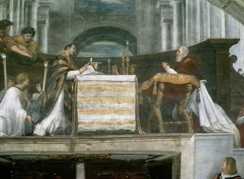
The Miracle Microbe: Serratia
marcescens


|
NAME:
Serratia marcescens
IMAGE
SIZE: 16 microns
IMAGE
CREDITS: Shirley Owens and Catherine McGowan, Microbe
Zoo Project, Comm Tech Lab, Michigan State
University.
Click
image to download large 640 x 480 JPEG
image
(approximate download times: 28.8 k = 40 sec; T1 = 11
sec.)
|
|

The Miracle of Bolsena is depicted
on the walls of the Vatican in this painting by
Raphael.
The German priest Peter of Prague is shown breaking bread
for communion
at the Church of Saint Christina in Bolsena,
Italy.
Imagine
Peter's surprise when he broke the communion wafer and saw
it had blood on it! The bread had truly become Jesus'
flesh!
|

|

|
|
Or had
it?
|
|
|


The year was 1263,
four hundred years before Antonie van Leeuwenhoek would first see
bacteria
under a microscope. In1264 to honor of the miracle of Bolsena, Pope
Urban instituted the feast of Corpus Christi (Body of Christ).
Neither the Pope nor Peter the Priest could ever have known that a
red bacterium,
Serratia marscesens, was the probable cause of this blood-like
substance on the communion bread.
Most microbiologists
are all too familiar with Serratia marscescens, one of the
most frequent contaminants of Petri
plates in the
lab. This same organism also grows on bread and communion wafers
which have been stored in a damp place.
This common microbe
is found in soil, water, on plants and in animals.
Because this microbe
is so common, because of its bright red color and because it used to
be considered benign, scientists and teachers frequently used it in
experiments to track microbes and to demonstrate the importance of
hand washing. For example, it was used to in handshaking experiments
in which one person dipped a hand in a broth of S. marcescens
and then shook hands with another person who in turn shook the hand
of another and so on down the line.
More recently, S.
marcescens has been found to be pathogenic
to some people, and it is no longer recommended for use in schools
and is not as widely used to track bacterial movement in the
environment.
S. marcescens
has been used to determine the survival and fate of bacteria in
saline breast implants. Serratia appears to thrive in saline
breast implants, living on the glucose that diffuses across the
implant's outer shell.
So maybe S.
marcescens wasn't the miracle that the Pope expected, but this
tiny organism does remind us of the miraculous invisible life that is
all around.
|

|
For more
stories about S. marsescens and other interesting
microbes, read Power Unseen: How Microbes Rule the
World by Bernard Dixon. Oxford Univ. Press; ISBN:
071674550X.
|
|
|
|

Glossary
bacterium
- (plural = bacteria) - a simple, small microbe lacking a nucleus.
Bacteria are also called prokaryotes or monerans. Most bacteria are
unicellular, containing only a single cell. Sometimes bacteria appear
multicellular, living together in groups of cells. Bacteria comprise
two of the three domains of life, the Eubacteria and the
Archaea.
contaminant
- an organism growing where it is not wanted.
pathogenic
- disease causing. A microbe that causes disease is said to be
pathogenic.
communion
- Christian ceremony remembering the Last Supper of Christ. Some
believe in transsubstantiation, in which the bread and wine of
communion are turned into the presence of Christ.
Petri
plates - dishes filled with jello-like nutrients used to grow
microbes.
Pope
Urban - instituted the feast of Corpus Christi (Body of Christ)
in August 1264 after learning about the Miracle of
Bolsena.
Rafael
- Raffaello Sanzio (1483~1520),- great and influential
artist of the Italian Renaissance. Raphael was born in
Urbino, Italy. In 1504
Raphael moved to Florence where he learned from Leonardo and
Michelangelo.
© 1999 Comm Tech Lab, Michigan State Univeristy. This
work was created with support from the National Science Foundation
and the Center for Microbial Ecology at Michigan State University.
Current maintenance is supported by the International
Society for Microbial Ecology and the Comm
Tech Lab.
![]()


